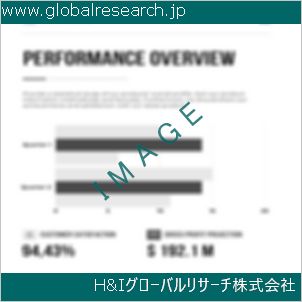1 市場概要
1.1 製品概要と範囲
1.2 市場推定の注意点と基準年
1.3 タイプ別市場分析
1.3.1 概要:グローバルな細胞培養バッファーの消費価値(タイプ別):2020年対2024年対2031年
1.3.2 酸性バッファー
1.3.3 アルカリ性バッファー
1.4 用途別市場分析
1.4.1 概要:グローバル細胞培養バッファーの消費額(用途別):2020年対2024年対2031年
1.4.2 細胞学
1.4.3 遺伝学
1.4.4 ライフサイエンス
1.4.5 製薬
1.4.6 その他
1.5 グローバル細胞培養緩衝液市場規模と予測
1.5.1 グローバル細胞培養緩衝液の消費額(2020年、2024年、2031年)
1.5.2 グローバル細胞培養緩衝液の販売数量(2020年~2031年)
1.5.3 グローバル細胞培養緩衝液の平均価格(2020-2031)
2 メーカープロファイル
2.1 Actylis
2.1.1 Actylisの詳細
2.1.2 Actylisの主要事業
2.1.3 Actylis 細胞培養緩衝液の製品とサービス
2.1.4 Actylis 細胞培養緩衝液の売上数量、平均価格、売上高、粗利益率、市場シェア(2020-2025)
2.1.5 Actylisの最近の動向/更新
2.2 Avantor
2.2.1 Avantorの概要
2.2.2 Avantor 主な事業
2.2.3 アバンター 細胞培養緩衝液 製品とサービス
2.2.4 Avantor 細胞培養緩衝液の販売数量、平均価格、売上高、粗利益率、市場シェア(2020-2025)
2.2.5 アバンター 最近の動向/更新
2.3 コルニング
2.3.1 コルニングの詳細
2.3.2 コルニングの主要事業
2.3.3 コルニング 細胞培養緩衝液 製品とサービス
2.3.4 コルニング 細胞培養バッファーの販売数量、平均価格、売上高、粗利益率、市場シェア(2020-2025)
2.3.5 コルニングの最近の動向/更新情報
2.4 サイトバ
2.4.1 サイトバの詳細
2.4.2 サイトバの主要事業
2.4.3 サイトバ 細胞培養緩衝液 製品とサービス
2.4.4 サイトバ 細胞培養緩衝液の売上数量、平均価格、売上高、粗利益率、市場シェア(2020-2025)
2.4.5 Cytivaの最近の動向/更新情報
2.5 Entegris
2.5.1 Entegrisの詳細
2.5.2 Entegris 主な事業
2.5.3 Entegris 細胞培養緩衝液の製品とサービス
2.5.4 Entegris 細胞培養緩衝液の売上数量、平均価格、売上高、粗利益率、市場シェア(2020-2025)
2.5.5 Entegris の最近の動向/更新
2.6 GE Healthcare
2.6.1 GE Healthcareの詳細
2.6.2 GE Healthcare 主な事業
2.6.3 GE Healthcare 細胞培養緩衝液の製品とサービス
2.6.4 GE Healthcare 細胞培養緩衝液の売上数量、平均価格、売上高、粗利益率、市場シェア(2020-2025)
2.6.5 GE Healthcareの最近の動向/更新
2.7 ホパックス・ファイン・ケミカルズ
2.7.1 Hopax Fine Chemicalsの詳細
2.7.2 Hopax Fine Chemicals 主な事業
2.7.3 Hopax Fine Chemicals 細胞培養緩衝液製品およびサービス
2.7.4 Hopax Fine Chemicals 細胞培養緩衝液の販売数量、平均価格、売上高、粗利益率、市場シェア(2020-2025)
2.7.5 ホパックス・ファイン・ケミカルズの最近の動向/更新情報
2.8 ロンザ
2.8.1 ロンザの詳細
2.8.2 Lonza 主な事業
2.8.3 Lonza 細胞培養緩衝液製品およびサービス
2.8.4 Lonza 細胞培養バッファーの売上数量、平均価格、売上高、粗利益率、市場シェア(2020-2025)
2.8.5 ロンザの最近の動向/更新
2.9 パル・コーポレーション
2.9.1 パル・コーポレーションの概要
2.9.2 パル・コーポレーションの主要事業
2.9.3 パル・コーポレーション 細胞培養緩衝液製品およびサービス
2.9.4 パル・コーポレーション 細胞培養緩衝液の売上数量、平均価格、売上高、粗利益率、市場シェア(2020-2025)
2.9.5 パル・コーポレーションの最近の動向/更新
2.10 サンゴバン
2.10.1 サンゴバン 詳細
2.10.2 サンゴバン主要事業
2.10.3 サンゴバン 細胞培養緩衝液 製品とサービス
2.10.4 サンゴバン 細胞培養緩衝液の売上数量、平均価格、売上高、粗利益率、市場シェア(2020-2025)
2.10.5 サンゴバン 最近の動向/更新情報
2.11 サートリウス
2.11.1 サートリウス詳細
2.11.2 サートリウス主要事業
2.11.3 サートリウス 細胞培養緩衝液 製品とサービス
2.11.4 サートリウス 細胞培養緩衝液の売上数量、平均価格、売上高、粗利益率、市場シェア(2020-2025)
2.11.5 サートリウス最近の動向/更新
2.12 シグマ・アルドリッチ
2.12.1 シグマアルドリッチの詳細
2.12.2 シグマアルドリッチの主要事業
2.12.3 シグマアルドリッチ 細胞培養緩衝液 製品とサービス
2.12.4 シグマアルドリッチ 細胞培養バッファーの販売数量、平均価格、売上高、粗利益率、市場シェア(2020-2025)
2.12.5 シグマ・アルドリッチの最近の動向/更新
2.13 サーモフィッシャーサイエンティフィック
2.13.1 Thermo Fisher Scientificの詳細
2.13.2 Thermo Fisher Scientific 主な事業
2.13.3 Thermo Fisher Scientific 細胞培養緩衝液製品およびサービス
2.13.4 Thermo Fisher Scientific 細胞培養緩衝液の売上数量、平均価格、売上高、粗利益率、市場シェア(2020-2025)
2.13.5 Thermo Fisher Scientific の最近の動向/更新
2.14 VWR International
2.14.1 VWR Internationalの詳細
2.14.2 VWR International 主な事業
2.14.3 VWR International 細胞培養緩衝液製品およびサービス
2.14.4 VWR International 細胞培養緩衝液の売上数量、平均価格、売上高、粗利益率、市場シェア(2020-2025)
2.14.5 VWR Internationalの最近の動向/更新
3 競争環境:細胞培養緩衝液(メーカー別)
3.1 グローバル細胞培養緩衝液の製造業者別販売数量(2020-2025)
3.2 グローバル細胞培養緩衝液の売上高(メーカー別)(2020-2025)
3.3 グローバル細胞培養緩衝液メーカー別平均価格(2020-2025)
3.4 市場シェア分析(2024年)
3.4.1 メーカー別細胞培養緩衝液の出荷量(売上高:$MM)と市場シェア(%):2024
3.4.2 2024年の細胞培養緩衝液メーカー上位3社の市場シェア
3.4.3 2024年の細胞培養緩衝液メーカー上位6社の市場シェア
3.5 細胞培養緩衝液市場:全体的な企業足跡分析
3.5.1 細胞培養緩衝液市場:地域別足跡
3.5.2 細胞培養緩衝液市場:企業製品タイプ別足跡
3.5.3 細胞培養緩衝液市場:企業製品用途別足跡
3.6 新規参入企業と市場参入障壁
3.7 合併、買収、契約、および提携
4 地域別消費分析
4.1 地域別グローバル細胞培養緩衝液市場規模
4.1.1 地域別グローバル細胞培養緩衝液販売数量(2020-2031)
4.1.2 地域別グローバル細胞培養バッファー消費額(2020-2031)
4.1.3 地域別グローバル細胞培養バッファー平均価格(2020-2031)
4.2 北米の細胞培養緩衝液の消費額(2020-2031)
4.3 欧州の細胞培養緩衝液の消費額(2020-2031)
4.4 アジア太平洋地域における細胞培養緩衝液の消費額(2020-2031)
4.5 南米の細胞培養緩衝液の消費額(2020-2031)
4.6 中東・アフリカ 細胞培養緩衝液の消費額(2020-2031)
5 市場セグメント別タイプ
5.1 グローバル細胞培養緩衝液の売上数量(タイプ別)(2020-2031)
5.2 グローバル細胞培養緩衝液のタイプ別消費額(2020-2031)
5.3 グローバル細胞培養緩衝液の平均価格(種類別)(2020-2031)
6 市場セグメント(用途別)
6.1 グローバル細胞培養緩衝液の用途別販売数量(2020-2031)
6.2 グローバル細胞培養緩衝液の用途別消費額(2020-2031)
6.3 グローバル細胞培養緩衝液の用途別平均価格(2020-2031)
7 北米
7.1 北米の細胞培養緩衝液の売上数量(タイプ別)(2020-2031)
7.2 北米 細胞培養緩衝液の売上数量(用途別)(2020-2031)
7.3 北米の細胞培養緩衝液市場規模(国別)
7.3.1 北米 細胞培養緩衝液の販売数量(国別)(2020-2031)
7.3.2 北米の細胞培養緩衝液の消費額(国別)(2020-2031)
7.3.3 アメリカ市場規模と予測(2020-2031)
7.3.4 カナダ市場規模と予測(2020-2031)
7.3.5 メキシコ市場規模と予測(2020-2031)
8 ヨーロッパ
8.1 ヨーロッパの細胞培養緩衝液の売上数量(種類別)(2020-2031)
8.2 欧州の細胞培養緩衝液の売上数量(用途別)(2020-2031)
8.3 欧州の細胞培養緩衝液市場規模(国別)
8.3.1 欧州の細胞培養緩衝液の販売数量(国別)(2020-2031)
8.3.2 欧州の細胞培養緩衝液の消費額(国別)(2020-2031)
8.3.3 ドイツ市場規模と予測(2020-2031)
8.3.4 フランス市場規模と予測(2020-2031)
8.3.5 イギリス市場規模と予測(2020-2031)
8.3.6 ロシア市場規模と予測(2020-2031)
8.3.7 イタリア市場規模と予測(2020-2031)
9 アジア太平洋
9.1 アジア太平洋地域 細胞培養緩衝液の販売量(種類別)(2020-2031)
9.2 アジア太平洋地域 細胞培養緩衝液の売上数量(用途別)(2020-2031)
9.3 アジア太平洋地域における細胞培養緩衝液の市場規模(地域別)
9.3.1 アジア太平洋地域における細胞培養緩衝液の販売数量(地域別)(2020-2031)
9.3.2 アジア太平洋地域 細胞培養緩衝液の地域別消費額(2020-2031)
9.3.3 中国市場規模と予測(2020-2031)
9.3.4 日本市場規模と予測(2020-2031)
9.3.5 韓国市場規模と予測(2020-2031)
9.3.6 インド市場規模と予測(2020-2031)
9.3.7 東南アジア市場規模と予測(2020-2031)
9.3.8 オーストラリア市場規模と予測(2020-2031)
10 南米
10.1 南米 細胞培養緩衝液の販売量(種類別)(2020-2031)
10.2 南米の細胞培養緩衝液の販売数量(用途別)(2020-2031)
10.3 南米の細胞培養緩衝液市場規模(国別)
10.3.1 南米の細胞培養緩衝液の販売数量(国別)(2020-2031)
10.3.2 南米の細胞培養緩衝液の消費額(国別)(2020-2031)
10.3.3 ブラジル市場規模と予測(2020-2031)
10.3.4 アルゼンチン市場規模と予測(2020-2031)
11 中東・アフリカ
11.1 中東・アフリカ 細胞培養緩衝液の売上数量(種類別)(2020-2031)
11.2 中東・アフリカ 細胞培養バッファーの売上数量(用途別)(2020-2031)
11.3 中東・アフリカ 細胞培養緩衝液市場規模(国別)
11.3.1 中東・アフリカ 細胞培養緩衝液の販売数量(国別)(2020-2031)
11.3.2 中東・アフリカ 細胞培養緩衝液 消費額(国別)(2020-2031)
11.3.3 トルコ市場規模と予測(2020-2031)
11.3.4 エジプト市場規模と予測(2020-2031)
11.3.5 サウジアラビア市場規模と予測(2020-2031)
11.3.6 南アフリカ市場規模と予測(2020-2031)
12 市場動向
12.1 細胞培養緩衝液市場ドライバー
12.2 細胞培養緩衝液市場の制約要因
12.3 細胞培養緩衝液のトレンド分析
12.4 ポーターの5つの力分析
12.4.1 新規参入の脅威
12.4.2 供給者の交渉力
12.4.3 購入者の交渉力
12.4.4 代替品の脅威
12.4.5 競争の激化
13 原材料と産業チェーン
13.1 細胞培養緩衝液の原材料と主要メーカー
13.2 細胞培養緩衝液の製造コストの割合
13.3 細胞培養緩衝液の製造プロセス
13.4 産業バリューチェーン分析
14 流通チャネル別出荷量
14.1 販売チャネル
14.1.1 直接エンドユーザー向け
14.1.2 卸売業者
14.2 細胞培養緩衝液の主要な卸売業者
14.3 細胞培養緩衝液の主要な顧客
15 研究結果と結論
16 付録
16.1 方法論
16.2 研究プロセスとデータソース
16.3 免責事項
1.1 Product Overview and Scope
1.2 Market Estimation Caveats and Base Year
1.3 Market Analysis by Type
1.3.1 Overview: Global Cell Culture Buffers Consumption Value by Type: 2020 Versus 2024 Versus 2031
1.3.2 Acidic Buffers
1.3.3 Alkaline Buffers
1.4 Market Analysis by Application
1.4.1 Overview: Global Cell Culture Buffers Consumption Value by Application: 2020 Versus 2024 Versus 2031
1.4.2 Cytology
1.4.3 Genetics
1.4.4 Life Sciences
1.4.5 Pharmaceutical
1.4.6 Others
1.5 Global Cell Culture Buffers Market Size & Forecast
1.5.1 Global Cell Culture Buffers Consumption Value (2020 & 2024 & 2031)
1.5.2 Global Cell Culture Buffers Sales Quantity (2020-2031)
1.5.3 Global Cell Culture Buffers Average Price (2020-2031)
2 Manufacturers Profiles
2.1 Actylis
2.1.1 Actylis Details
2.1.2 Actylis Major Business
2.1.3 Actylis Cell Culture Buffers Product and Services
2.1.4 Actylis Cell Culture Buffers Sales Quantity, Average Price, Revenue, Gross Margin and Market Share (2020-2025)
2.1.5 Actylis Recent Developments/Updates
2.2 Avantor
2.2.1 Avantor Details
2.2.2 Avantor Major Business
2.2.3 Avantor Cell Culture Buffers Product and Services
2.2.4 Avantor Cell Culture Buffers Sales Quantity, Average Price, Revenue, Gross Margin and Market Share (2020-2025)
2.2.5 Avantor Recent Developments/Updates
2.3 Corning
2.3.1 Corning Details
2.3.2 Corning Major Business
2.3.3 Corning Cell Culture Buffers Product and Services
2.3.4 Corning Cell Culture Buffers Sales Quantity, Average Price, Revenue, Gross Margin and Market Share (2020-2025)
2.3.5 Corning Recent Developments/Updates
2.4 Cytiva
2.4.1 Cytiva Details
2.4.2 Cytiva Major Business
2.4.3 Cytiva Cell Culture Buffers Product and Services
2.4.4 Cytiva Cell Culture Buffers Sales Quantity, Average Price, Revenue, Gross Margin and Market Share (2020-2025)
2.4.5 Cytiva Recent Developments/Updates
2.5 Entegris
2.5.1 Entegris Details
2.5.2 Entegris Major Business
2.5.3 Entegris Cell Culture Buffers Product and Services
2.5.4 Entegris Cell Culture Buffers Sales Quantity, Average Price, Revenue, Gross Margin and Market Share (2020-2025)
2.5.5 Entegris Recent Developments/Updates
2.6 GE Healthcare
2.6.1 GE Healthcare Details
2.6.2 GE Healthcare Major Business
2.6.3 GE Healthcare Cell Culture Buffers Product and Services
2.6.4 GE Healthcare Cell Culture Buffers Sales Quantity, Average Price, Revenue, Gross Margin and Market Share (2020-2025)
2.6.5 GE Healthcare Recent Developments/Updates
2.7 Hopax Fine Chemicals
2.7.1 Hopax Fine Chemicals Details
2.7.2 Hopax Fine Chemicals Major Business
2.7.3 Hopax Fine Chemicals Cell Culture Buffers Product and Services
2.7.4 Hopax Fine Chemicals Cell Culture Buffers Sales Quantity, Average Price, Revenue, Gross Margin and Market Share (2020-2025)
2.7.5 Hopax Fine Chemicals Recent Developments/Updates
2.8 Lonza
2.8.1 Lonza Details
2.8.2 Lonza Major Business
2.8.3 Lonza Cell Culture Buffers Product and Services
2.8.4 Lonza Cell Culture Buffers Sales Quantity, Average Price, Revenue, Gross Margin and Market Share (2020-2025)
2.8.5 Lonza Recent Developments/Updates
2.9 Pall Corporation
2.9.1 Pall Corporation Details
2.9.2 Pall Corporation Major Business
2.9.3 Pall Corporation Cell Culture Buffers Product and Services
2.9.4 Pall Corporation Cell Culture Buffers Sales Quantity, Average Price, Revenue, Gross Margin and Market Share (2020-2025)
2.9.5 Pall Corporation Recent Developments/Updates
2.10 Saint-Gobain
2.10.1 Saint-Gobain Details
2.10.2 Saint-Gobain Major Business
2.10.3 Saint-Gobain Cell Culture Buffers Product and Services
2.10.4 Saint-Gobain Cell Culture Buffers Sales Quantity, Average Price, Revenue, Gross Margin and Market Share (2020-2025)
2.10.5 Saint-Gobain Recent Developments/Updates
2.11 Sartorius
2.11.1 Sartorius Details
2.11.2 Sartorius Major Business
2.11.3 Sartorius Cell Culture Buffers Product and Services
2.11.4 Sartorius Cell Culture Buffers Sales Quantity, Average Price, Revenue, Gross Margin and Market Share (2020-2025)
2.11.5 Sartorius Recent Developments/Updates
2.12 Sigma-Aldrich
2.12.1 Sigma-Aldrich Details
2.12.2 Sigma-Aldrich Major Business
2.12.3 Sigma-Aldrich Cell Culture Buffers Product and Services
2.12.4 Sigma-Aldrich Cell Culture Buffers Sales Quantity, Average Price, Revenue, Gross Margin and Market Share (2020-2025)
2.12.5 Sigma-Aldrich Recent Developments/Updates
2.13 Thermo Fisher Scientific
2.13.1 Thermo Fisher Scientific Details
2.13.2 Thermo Fisher Scientific Major Business
2.13.3 Thermo Fisher Scientific Cell Culture Buffers Product and Services
2.13.4 Thermo Fisher Scientific Cell Culture Buffers Sales Quantity, Average Price, Revenue, Gross Margin and Market Share (2020-2025)
2.13.5 Thermo Fisher Scientific Recent Developments/Updates
2.14 VWR International
2.14.1 VWR International Details
2.14.2 VWR International Major Business
2.14.3 VWR International Cell Culture Buffers Product and Services
2.14.4 VWR International Cell Culture Buffers Sales Quantity, Average Price, Revenue, Gross Margin and Market Share (2020-2025)
2.14.5 VWR International Recent Developments/Updates
3 Competitive Environment: Cell Culture Buffers by Manufacturer
3.1 Global Cell Culture Buffers Sales Quantity by Manufacturer (2020-2025)
3.2 Global Cell Culture Buffers Revenue by Manufacturer (2020-2025)
3.3 Global Cell Culture Buffers Average Price by Manufacturer (2020-2025)
3.4 Market Share Analysis (2024)
3.4.1 Producer Shipments of Cell Culture Buffers by Manufacturer Revenue ($MM) and Market Share (%): 2024
3.4.2 Top 3 Cell Culture Buffers Manufacturer Market Share in 2024
3.4.3 Top 6 Cell Culture Buffers Manufacturer Market Share in 2024
3.5 Cell Culture Buffers Market: Overall Company Footprint Analysis
3.5.1 Cell Culture Buffers Market: Region Footprint
3.5.2 Cell Culture Buffers Market: Company Product Type Footprint
3.5.3 Cell Culture Buffers Market: Company Product Application Footprint
3.6 New Market Entrants and Barriers to Market Entry
3.7 Mergers, Acquisition, Agreements, and Collaborations
4 Consumption Analysis by Region
4.1 Global Cell Culture Buffers Market Size by Region
4.1.1 Global Cell Culture Buffers Sales Quantity by Region (2020-2031)
4.1.2 Global Cell Culture Buffers Consumption Value by Region (2020-2031)
4.1.3 Global Cell Culture Buffers Average Price by Region (2020-2031)
4.2 North America Cell Culture Buffers Consumption Value (2020-2031)
4.3 Europe Cell Culture Buffers Consumption Value (2020-2031)
4.4 Asia-Pacific Cell Culture Buffers Consumption Value (2020-2031)
4.5 South America Cell Culture Buffers Consumption Value (2020-2031)
4.6 Middle East & Africa Cell Culture Buffers Consumption Value (2020-2031)
5 Market Segment by Type
5.1 Global Cell Culture Buffers Sales Quantity by Type (2020-2031)
5.2 Global Cell Culture Buffers Consumption Value by Type (2020-2031)
5.3 Global Cell Culture Buffers Average Price by Type (2020-2031)
6 Market Segment by Application
6.1 Global Cell Culture Buffers Sales Quantity by Application (2020-2031)
6.2 Global Cell Culture Buffers Consumption Value by Application (2020-2031)
6.3 Global Cell Culture Buffers Average Price by Application (2020-2031)
7 North America
7.1 North America Cell Culture Buffers Sales Quantity by Type (2020-2031)
7.2 North America Cell Culture Buffers Sales Quantity by Application (2020-2031)
7.3 North America Cell Culture Buffers Market Size by Country
7.3.1 North America Cell Culture Buffers Sales Quantity by Country (2020-2031)
7.3.2 North America Cell Culture Buffers Consumption Value by Country (2020-2031)
7.3.3 United States Market Size and Forecast (2020-2031)
7.3.4 Canada Market Size and Forecast (2020-2031)
7.3.5 Mexico Market Size and Forecast (2020-2031)
8 Europe
8.1 Europe Cell Culture Buffers Sales Quantity by Type (2020-2031)
8.2 Europe Cell Culture Buffers Sales Quantity by Application (2020-2031)
8.3 Europe Cell Culture Buffers Market Size by Country
8.3.1 Europe Cell Culture Buffers Sales Quantity by Country (2020-2031)
8.3.2 Europe Cell Culture Buffers Consumption Value by Country (2020-2031)
8.3.3 Germany Market Size and Forecast (2020-2031)
8.3.4 France Market Size and Forecast (2020-2031)
8.3.5 United Kingdom Market Size and Forecast (2020-2031)
8.3.6 Russia Market Size and Forecast (2020-2031)
8.3.7 Italy Market Size and Forecast (2020-2031)
9 Asia-Pacific
9.1 Asia-Pacific Cell Culture Buffers Sales Quantity by Type (2020-2031)
9.2 Asia-Pacific Cell Culture Buffers Sales Quantity by Application (2020-2031)
9.3 Asia-Pacific Cell Culture Buffers Market Size by Region
9.3.1 Asia-Pacific Cell Culture Buffers Sales Quantity by Region (2020-2031)
9.3.2 Asia-Pacific Cell Culture Buffers Consumption Value by Region (2020-2031)
9.3.3 China Market Size and Forecast (2020-2031)
9.3.4 Japan Market Size and Forecast (2020-2031)
9.3.5 South Korea Market Size and Forecast (2020-2031)
9.3.6 India Market Size and Forecast (2020-2031)
9.3.7 Southeast Asia Market Size and Forecast (2020-2031)
9.3.8 Australia Market Size and Forecast (2020-2031)
10 South America
10.1 South America Cell Culture Buffers Sales Quantity by Type (2020-2031)
10.2 South America Cell Culture Buffers Sales Quantity by Application (2020-2031)
10.3 South America Cell Culture Buffers Market Size by Country
10.3.1 South America Cell Culture Buffers Sales Quantity by Country (2020-2031)
10.3.2 South America Cell Culture Buffers Consumption Value by Country (2020-2031)
10.3.3 Brazil Market Size and Forecast (2020-2031)
10.3.4 Argentina Market Size and Forecast (2020-2031)
11 Middle East & Africa
11.1 Middle East & Africa Cell Culture Buffers Sales Quantity by Type (2020-2031)
11.2 Middle East & Africa Cell Culture Buffers Sales Quantity by Application (2020-2031)
11.3 Middle East & Africa Cell Culture Buffers Market Size by Country
11.3.1 Middle East & Africa Cell Culture Buffers Sales Quantity by Country (2020-2031)
11.3.2 Middle East & Africa Cell Culture Buffers Consumption Value by Country (2020-2031)
11.3.3 Turkey Market Size and Forecast (2020-2031)
11.3.4 Egypt Market Size and Forecast (2020-2031)
11.3.5 Saudi Arabia Market Size and Forecast (2020-2031)
11.3.6 South Africa Market Size and Forecast (2020-2031)
12 Market Dynamics
12.1 Cell Culture Buffers Market Drivers
12.2 Cell Culture Buffers Market Restraints
12.3 Cell Culture Buffers Trends Analysis
12.4 Porters Five Forces Analysis
12.4.1 Threat of New Entrants
12.4.2 Bargaining Power of Suppliers
12.4.3 Bargaining Power of Buyers
12.4.4 Threat of Substitutes
12.4.5 Competitive Rivalry
13 Raw Material and Industry Chain
13.1 Raw Material of Cell Culture Buffers and Key Manufacturers
13.2 Manufacturing Costs Percentage of Cell Culture Buffers
13.3 Cell Culture Buffers Production Process
13.4 Industry Value Chain Analysis
14 Shipments by Distribution Channel
14.1 Sales Channel
14.1.1 Direct to End-User
14.1.2 Distributors
14.2 Cell Culture Buffers Typical Distributors
14.3 Cell Culture Buffers Typical Customers
15 Research Findings and Conclusion
16 Appendix
16.1 Methodology
16.2 Research Process and Data Source
16.3 Disclaimer
| ※参考情報 細胞培養バッファーは、細胞の生長や維持のために不可欠な溶液であり、細胞培養の際に使用されます。細胞培養とは、細胞を人工的な環境で育てる技術であり、研究や医療、バイオテクノロジーの分野で幅広く利用されています。バッファーは、細胞の外部環境を制御し、必要な栄養素を提供するとともに、pHや浸透圧などの物理的特性を安定させる役割を果たします。 細胞培養バッファーの主な目的は、細胞が正常に機能するために必要な条件を提供することです。これは、細胞が成長し、分裂し、機能するためには一定のpH範囲が求められるためです。通常の細胞は、pH 7.2から7.4の間で最も良好に生育します。バッファーはこのpHを維持するために設計されており、体液と同様の条件を再現することを目指しています。 細胞培養バッファーには、いくつかの特徴があります。第一に、バッファーは目標とするpHを維持する能力があります。一般的なバッファーは、酸や塩基を加えた際に、そのpHの変化を最小限に抑えることができます。第二に、バッファーは浸透圧を調整するために、適切な塩類や栄養素を含むことが求められます。細胞が過剰な浸透圧ストレスを受けると、細胞の機能が損なわれる恐れがあります。第三に、細胞培養バッファーは、細胞の栄養供給を行うために、必須のアミノ酸、ビタミン、グルコースなどを含むことが多いです。 細胞培養バッファーは、いくつかの種類に分類されます。代表的なものとしては、Dulbeccoの修正エグルーバー培地(DMEM)、Modified Eagle's Medium(MEM)、RPMI-1640などが挙げられます。これらの培地は異なる組成を持ち、特定の細胞ラインやセルタイプに応じて最適化されています。例えば、DMEMは多種類の細胞に適しており、特に高度に増殖する細胞株に用いられます。一方、RPMI-1640は、白血球やリンパ球の培養に適しているため、免疫系の研究でよく使用されます。 用途としては、細胞培養バッファーは主に細胞の増殖、分化、発現解析、薬剤スクリーニング、ウイルスの生産、抗体の生成などに用いられます。製薬会社やバイオテクノロジー企業では、細胞培養を通じて新しい医薬品の開発を行っています。また、基礎研究では、細胞の基本的な生物学的機能を理解するための実験が行われています。 細胞培養バッファーに関連する技術には、培養条件の最適化や、自動化技術、マイクロ流体技術があります。培養条件の最適化は、特定の細胞株にとって最良の成長環境を見つけ出す過程です。これには、栄養素の濃度やpH、温度、二酸化炭素レベルを調整することが含まれます。自動化技術は、大規模な細胞培養を効率的に行うためのものであり、高スループットスクリーニングや細胞のモニタリングを可能にします。マイクロ流体技術は、小さなスケールで細胞の反応を観察する手法であり、より精密な実験が可能になります。 さらに、細胞培養バッファーの選択は、研究の目的や細胞ラインに応じて行われます。例えば、神経細胞を培養する場合は、神経栄養因子が豊富に含まれている培地が選ばれることがあります。一方、癌細胞の研究では、特定の成長因子を含むバッファーが選ばれることがあります。これによって、細胞が本来持っている特性を最大限に引き出すことができ、実験結果の信頼性を高めることができます。 また、細胞培養バッファーは無菌環境でも用いられ、微生物汚染を防ぐために抗生物質が添加されることがあります。これにより、培養されている細胞の純度が保たれ、実験の結果に悪影響を及ぼすことを防ぐことができます。 最近では、細胞培養の研究が進むにつれて、オルガノイドやテトラミックなどの新しい培養技術が注目を集めています。これらは、より複雑な生理的状態を再現できるため、将来的な医療分野での応用が期待されています。これにより、細胞培養バッファーの設計にもさらなる革新が求められています。 最後に、細胞培養バッファーは、生命科学の進展において欠かせない重要な要素であり、基礎研究から応用研究に至るまで広範な利用がなされています。今後も、新しい培養技術やバッファーの開発が行われ、より高精度で再現性のある研究が実現されることが期待されています。細胞培養の技術革新は、医学や生物学の最前線において、さらなる理解と発展を促進する鍵となっているのです。 |
❖ 免責事項 ❖
http://www.globalresearch.jp/disclaimer












